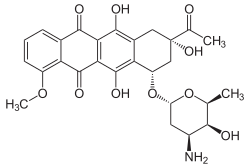Daunorubicin
An anthracycline antibiotic used in cancer treatment
| Daunorubicin | |
|---|---|

| |
| INN | |
| Drug class | |
| Routes of administration | |
| Pregnancy category | |
| Bioavailability | |
| Metabolism | |
| Elimination half-life | |
| Excretion | |
| Legal status | |
| CAS Number | |
| PubChem | |
| DrugBank | |
| ChemSpider | |
| KEGG | |
Daunorubicin, also known as daunomycin, is an anthracycline antibiotic that is primarily used in the treatment of certain types of cancer, including acute myeloid leukemia (AML) and acute lymphoblastic leukemia (ALL). It is a chemotherapy agent that works by intercalating DNA, thereby inhibiting the synthesis of nucleic acids and inducing apoptosis in rapidly dividing cells.
Mechanism of Action
Daunorubicin exerts its effects by intercalating between base pairs in the DNA helix, thereby disrupting the function of topoisomerase II, an enzyme critical for DNA replication and repair. This interference prevents the proper unwinding of DNA, leading to breaks in the DNA strands and ultimately triggering cell death. Additionally, daunorubicin generates free radicals that cause further damage to cellular components.
Clinical Uses
Daunorubicin is primarily used in the treatment of:
- Acute myeloid leukemia (AML)
- Acute lymphoblastic leukemia (ALL)
It is often used in combination with other chemotherapeutic agents, such as cytarabine, to enhance its efficacy. The drug is administered intravenously, allowing it to rapidly reach systemic circulation and target cancerous cells throughout the body.
Side Effects
The use of daunorubicin is associated with several side effects, which can vary in severity. Common side effects include:
- Myelosuppression, leading to decreased production of blood cells
- Nausea and vomiting
- Alopecia (hair loss)
- Cardiotoxicity, which can lead to congestive heart failure
Due to its potential to cause cardiotoxicity, the cumulative dose of daunorubicin is carefully monitored, and patients may undergo regular cardiac evaluations during treatment.
Pharmacokinetics
Daunorubicin is metabolized primarily in the liver and is excreted in the bile and urine. Its half-life is approximately 18.5 hours, allowing for effective dosing schedules in chemotherapy regimens. The drug's lipophilic nature facilitates its penetration into tissues, including the central nervous system, although its efficacy in treating central nervous system leukemia is limited.
History
Daunorubicin was first isolated from the bacterium Streptomyces peucetius in the 1960s. It was one of the first anthracyclines to be used in clinical practice and paved the way for the development of other related compounds, such as doxorubicin.
Related pages
| Chemotherapy | ||||||||||
|---|---|---|---|---|---|---|---|---|---|---|
This Chemotherapy related article is a stub.
|
Transform your life with W8MD's budget GLP-1 injections from $125.
W8MD offers a medical weight loss program to lose weight in Philadelphia. Our physician-supervised medical weight loss provides:
- Most insurances accepted or discounted self-pay rates. We will obtain insurance prior authorizations if needed.
- Generic GLP1 weight loss injections from $125 for the starting dose.
- Also offer prescription weight loss medications including Phentermine, Qsymia, Diethylpropion, Contrave etc.
NYC weight loss doctor appointments
Start your NYC weight loss journey today at our NYC medical weight loss and Philadelphia medical weight loss clinics.
- Call 718-946-5500 to lose weight in NYC or for medical weight loss in Philadelphia 215-676-2334.
- Tags:NYC medical weight loss, Philadelphia lose weight Zepbound NYC, Budget GLP1 weight loss injections, Wegovy Philadelphia, Wegovy NYC, Philadelphia medical weight loss, Brookly weight loss and Wegovy NYC
|
WikiMD's Wellness Encyclopedia |
| Let Food Be Thy Medicine Medicine Thy Food - Hippocrates |
Medical Disclaimer: WikiMD is not a substitute for professional medical advice. The information on WikiMD is provided as an information resource only, may be incorrect, outdated or misleading, and is not to be used or relied on for any diagnostic or treatment purposes. Please consult your health care provider before making any healthcare decisions or for guidance about a specific medical condition. WikiMD expressly disclaims responsibility, and shall have no liability, for any damages, loss, injury, or liability whatsoever suffered as a result of your reliance on the information contained in this site. By visiting this site you agree to the foregoing terms and conditions, which may from time to time be changed or supplemented by WikiMD. If you do not agree to the foregoing terms and conditions, you should not enter or use this site. See full disclaimer.
Credits:Most images are courtesy of Wikimedia commons, and templates, categories Wikipedia, licensed under CC BY SA or similar.
Contributors: Prab R. Tumpati, MD


